Empire of Japan Group Build. 1/48 Fine Molds Nakajima “Kikka” Jet
75 Years ago today this plane took it's very first flight. It took a very long time to get airborne, so several days later another flight was made... or at least attempted. They had installed RATO pods under the wings in an effort to help get the plane airborne. This is how I built my plane, as the holes for the pods were already there and I took the easy way out instead of filling them in.
This is what Wikipedia has to say about the actual aircraft: I have copied this directly from the Wiki website, so the credit for the history behind this plane should go there. Anyone can simply copy and paste...
The Nakajima Kikka (中島 橘花, "Orange Blossom") was Japan's first jet aircraft. It was developed late in World War II and the first prototype had only flown once before the end of the conflict. It was also called Kōkoku Nigō Heiki (皇国二号兵器, "Imperial Weapon No.2").
After the Japanese military attache in Germany witnessed trials of the Messerschmidt Me 262 in 1942, the Imperial Japanese Navy issued a request to Nakajima to develop a similar aircraft to be used as a fast attack bomber. Among the specifications for the design were the requirements that it should be able to be built largely by unskilled labor, and that the wings should be fold-able. This latter feature was to enable the aircraft to be hidden in caves and tunnels around Japan as the navy began to prepare for the defense of the home islands. Nakajima designers Kazuo Ohno and Kenichi Matsumura laid out an aircraft that bore a strong but superficial resemblance to the Me 262.
The Kikka was designed in preliminary form to use the Tsu-11, a very crude motor jet style of jet engine that was little more than a ducted fan with an afterburner. Subsequent designs were planned around the Ne-10 (TR-10) centrifugal-flow turbojet, and the Ne-12, which added a four-stage axial compressor to the front of the Ne-10. Tests of this power plant soon revealed that it would not produce anywhere near the power required to propel the aircraft, and the project was temporarily stalled. It was then decided to produce a new axial flow turbojet based on the German BMW 003.
Development of the engine was troublesome, based on little more than photographs and a cut-away drawing; but a suitable unit, the Ishikawajima Ne-20, was finally built. By mid-1945, the Kikka project was making progress once again and at this stage, reflecting the deteriorating war situation, it is possible that the Navy considered employing the Kikka as a kamikaze weapon although the prospect was questionable due to the high cost and complexity associated with contemporary turbojet engines. As well, other more economical projects meant specifically for the role such as the simple Nakajima Tōka (designed to absorb Japanese stock of obsolete engines), the pulsejet-powered Kawanishi Baika, and the infamous Yokosuka Ohka, were either underway or already in mass production.
Compared to the Me 262, the Kikka airframe was noticeably smaller and even more conventional in design, with straight wings (lacking the slight sweepback of the Me 262) and tail surfaces. The triangular fuselage cross section characteristic of the German design was less pronounced, due to smaller fuel tanks. The main landing gear of the Kikka was taken from the A6M Zero and the nose wheel from the tail of a Yokosuka P1Y bomber.
The Kikka is often identified as the Nakajima J9N1, or occasionally J9Y, which according to a researcher at the National Air and Space Museum is incorrect. The official name given to the aircraft was 橘花 "Kitsuka," pronounced Kikka in Kanji used traditionally by the Japanese. Like other Japanese aircraft intended for use in suicide missions, it received only a name. Imperial Japanese Naval aircraft were designated similar to U.S. Naval aircraft of the time frame. A first letter, denoting the role/type of aircraft, separated by a number that denotes where in the series of aircraft of the same role the aircraft resides, followed by a second letter denoting the design and manufacturing firm, and finally, a second number denoting the aircraft sub-type. The first three characters remain constant through all the sub-variants an aircraft might be built to.
Operational history
The Nakajima Kikka, equipped with RATO rockets for lift off.
The first prototype commenced ground tests at the Nakajima factory on 30 June 1945. The following month it was dismantled and delivered to Kisarazu Naval Airfield where it was re-assembled and prepared for flight testing. The first flight took place on 7 August 1945 (the day after Hiroshima was bombed by atomic bomb), with Lieutenant Commander Susumu Takaoka at the controls. The aircraft performed well during a 20-minute test flight, with the only concern being the length of the takeoff run. For the second test flight, four days later (4 days prior to Japan's declaration of surrender), rocket assisted take off (RATO) units were fitted to the aircraft.
The pilot had been uneasy about the angle at which the rocket tubes had been set, but with no time to correct them they decided to simply reduce the thrust of the rockets from 800 kg to only 400 kg. Four seconds into take off the RATO was actuated, immediately jolting the aircraft back onto its tail leaving the pilot with no effective tail control. After the nine-second burning time of the RATO ran out the nose came down and the nose wheel contacted the runway, resulting in a sudden deceleration, however both engines were still functioning normally.
At this point the pilot opted to abort the take off, but fighting to brake the aircraft and perform a ground loop only put him in danger of running it into other installations. Eventually the aircraft ran over a drainage ditch which caught the tricycle landing gear, the aircraft continued to skid forward and stopped short of the water's edge. Before it could be repaired Japan had surrendered and the war was over.
At this point, the second prototype was close to completion, and approximately 23 more air-frames were under construction. One of these was a two-seat trainer. Other follow-on versions proposed had included a reconnaissance aircraft, and a fighter armed with two 30 mm Type 5 cannons with 50 rounds per gun. These were expected to be powered by more advanced developments of the Ne-20, known as Ne-20-Kai 5.59 kN (570 kgf) or Ne-130 8.826 kN (900 kgf) or Ne-230 8.679 kN (885 kgf) or Ne-330 13.043 kN (1330 kgf), which were planned to have approximately 15% to 140% better thrust than the Ne-20.
Postwar
A Kikka stationed at the Patuxent River Naval Air Base, Maryland, 1946
Nakajima Kikka in the Steven F. Udvar-Hazy Center
After the war, airframes 3, 4, and 5 (and possibly other partial air-frames) were brought to the U.S. for study. Today, two examples survive in the National Air and Space Museum: The first is a Kikka that was taken to the Patuxent River Naval Air Base, Maryland for analysis. This aircraft is very incomplete and is believed to have been patched together from a variety of semi-completed air-frames. It is seen in the black and white photo in bare metal with two Ne-20 engines mounted under the wings. It is currently still in storage at the Paul E. Garber Preservation, Restoration and Storage Facility in Silver Hill, MD. The second Kikka is on display at the NASM Udvar-Hazy Center in the Mary Baker Engen Restoration Hangar.
Correspondence in 2001 with Japanese propulsion specialist Kazuhiko Ishizawa theorized that Nakajima constructed the Museum's Kikka air-frame for load testing, not for flight tests. This may explain why the engine nacelles on the Museum's Kikka air-frame are too small to enclose the Ne-20 engines.
Two Ne-20 jet engines had been taken to the US and sent for analysis to the Chrysler Corporation in 1946. This was only revealed in 2005 by W. I. Chapman, who was in charge of the project at the time. A working engine was assembled with the parts of the two Ne-20s, and tested for 11 hours and 46 minutes. A report was issued on 7 April 1947, titled "Japanese NE-20 turbo jet engine. Construction and performance". The document is now on display at the Tokyo National Science Museum.
Variants:
Nakajima Aircraft Company developed some variants of the aircraft:
There was also a modified version of the design to be launched from a 200 m long catapult, the "Nakajima Kikka-kai Prototype Turbojet Special Attacker". This differed in having a projected total weight of 4,080 kg and a maximum speed of 687 km/h at 6,000 m.
Specifications (Kikka)
Data from Japanese Aircraft of the Pacific War
General characteristics
Crew: 1
Length: 8.125 m (26 ft 8 in)
Wingspan: 10 m (32 ft 10 in)
Height: 2.95 m (9 ft 8 in)
Wing area: 13.2 M2 (142 sq ft)
Empty weight: 2,300 kg (5,071 lb)
Gross weight: 3,500 kg (7,716 lb)
Max takeoff weight: 4,080 kg (8,995 lb)
Powerplant: 2 × Ishikawajima Ne-20 axial-flow turbojet engines, 4.66 kN (1,047 lbf) thrust each
Performance
Maximum speed: 623 km/h (387 mph, 336 kn) at sea level
696 km/h (432 mph; 376 kn) at 10,000 m (32,808 ft)
Range: 943 km (586 mi, 509 nmi)
Service ceiling: 12,000 m (39,000 ft)
Rate of climb: 6.42 m/s (1,264 ft/min)
Time to altitude: 10,000 m (32,808 ft) in 26 minutes
Wing loading: 265 kg/m2 (54 lb/sq ft)
Thrust/weight: 0.27
Armament
Guns: 2 × 30 mm (1.181 in) Type 5 cannon
Bombs: 1 × 500 kg (1,102 lb), or 1 × 800 kg (1,764 lb) bomb
Bare metal foil was used inside the landing gear bays to simulate the unpainted metal of the inner wing.
The cockpit is OK from the box, but improvements could be made if one wanted to. The canopy is one piece and a little thick, so I didn't bother.
Here are a few pictures that show just how much smaller the Kikka was when compared to the larger Me-262. The overal RLM 76 colored 262 is a 1/48 scale Tamiya model, while the dark green mottled over RLM 76 Me-262 jet is the much older Monogram kit, also in 1/48 scale. These pictures will give you a good idea as to just how small this jet was.
This model was built straight from the box, and not other additions were made. The fit was very good, and it only needed a little filler where the lower wing section joined the fuselage. This could have been caused by me and might not be a fault of the kit.
I had a lot of fun building this jet. You can see the entire process if you are interested by following this link. This model was painted using the now discontinued line of Model Master enamels.
It was finished about 1.5 months ago, but I waited until the 75th anniversary of it's first flight to post the completed model here. I hope you enjoy reading about this model, as much as I enjoyed building it and doing the research on the type. This kit is not built up very often, and that is a shame, as it really builds into a nice looking model straight from the box, and the fit is very good.
Currently, the "Empire of Japan" group build is going underway at full speed. please fell free to join us, as there is always room for another kit.
As always, comments are encouraged. Please stay safe.
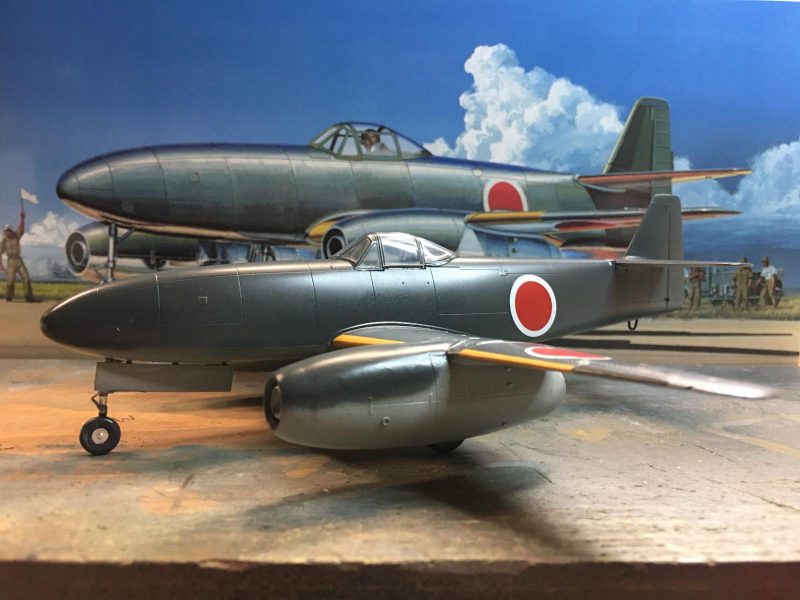
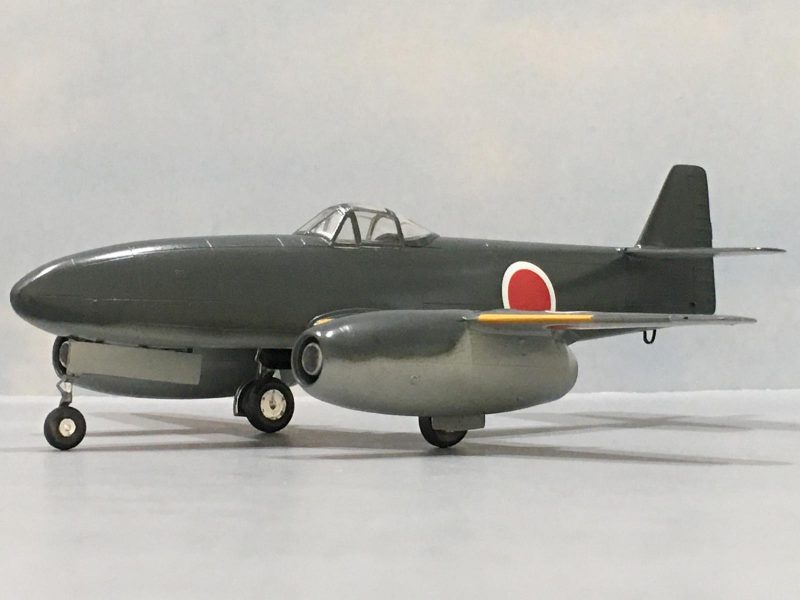
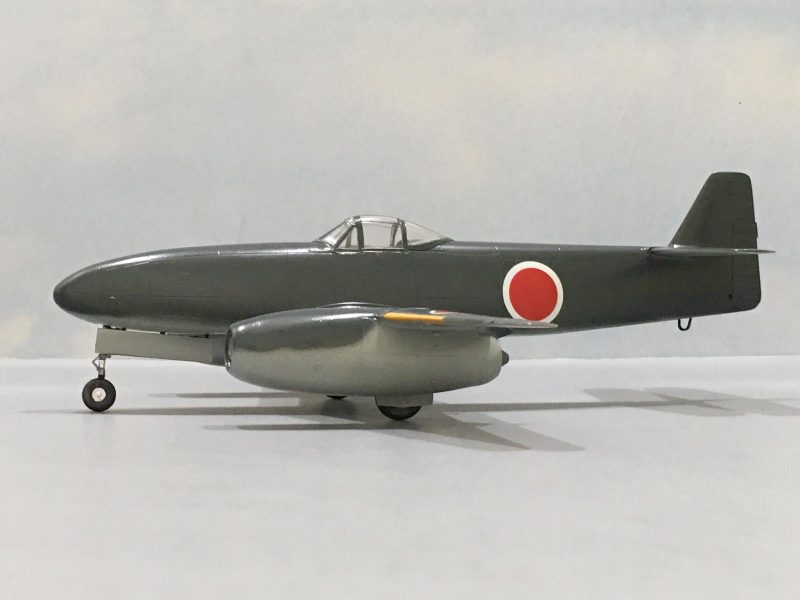
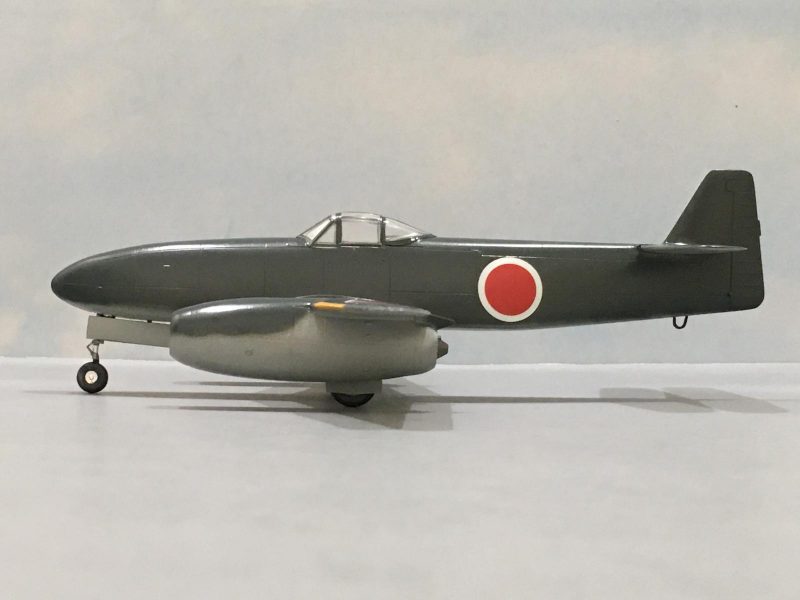
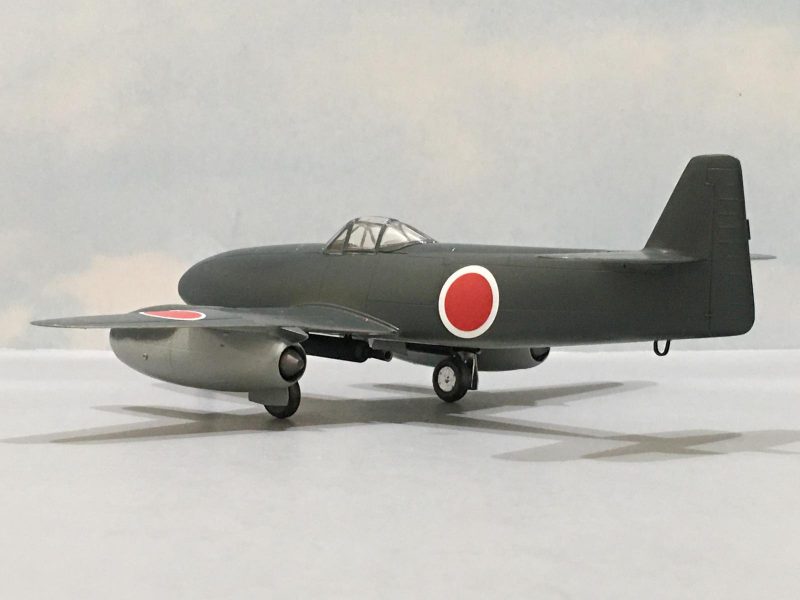

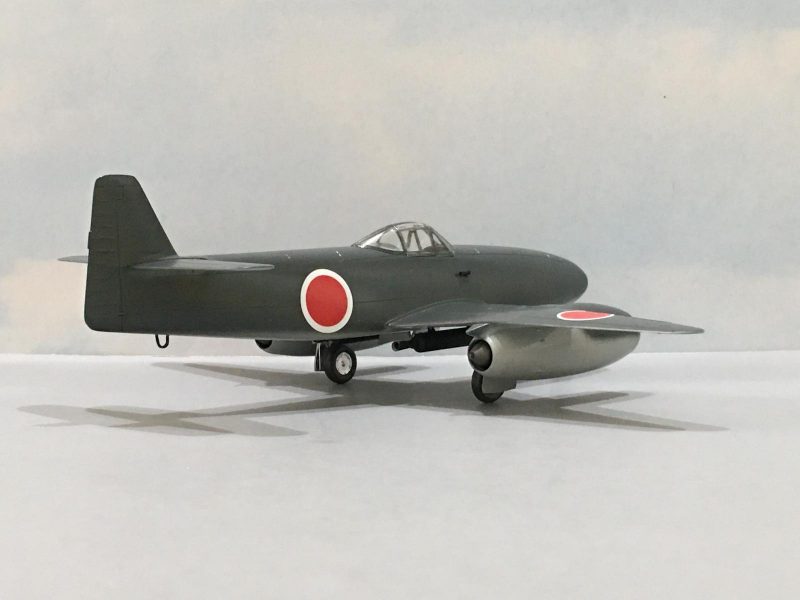
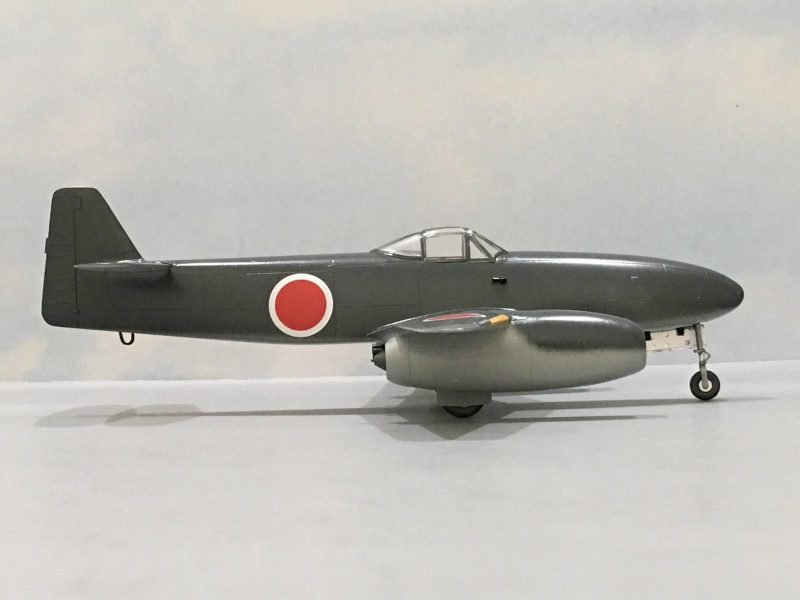

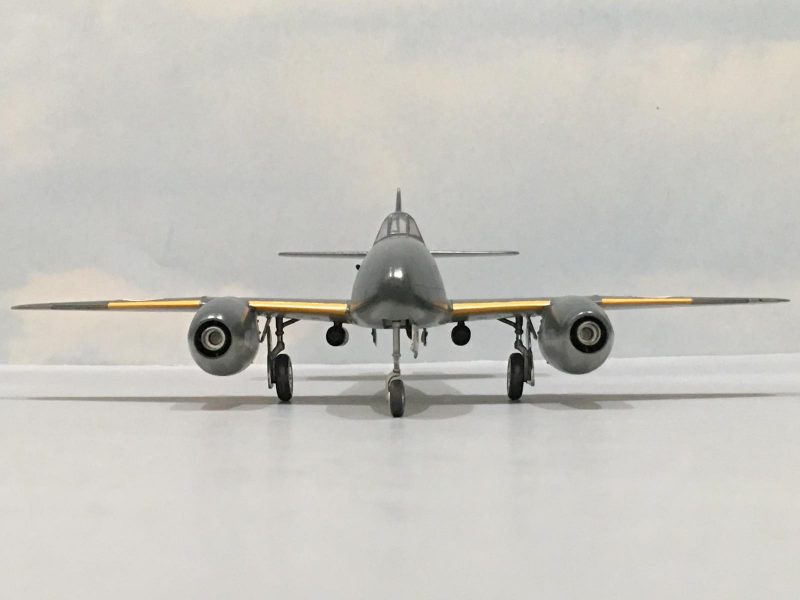
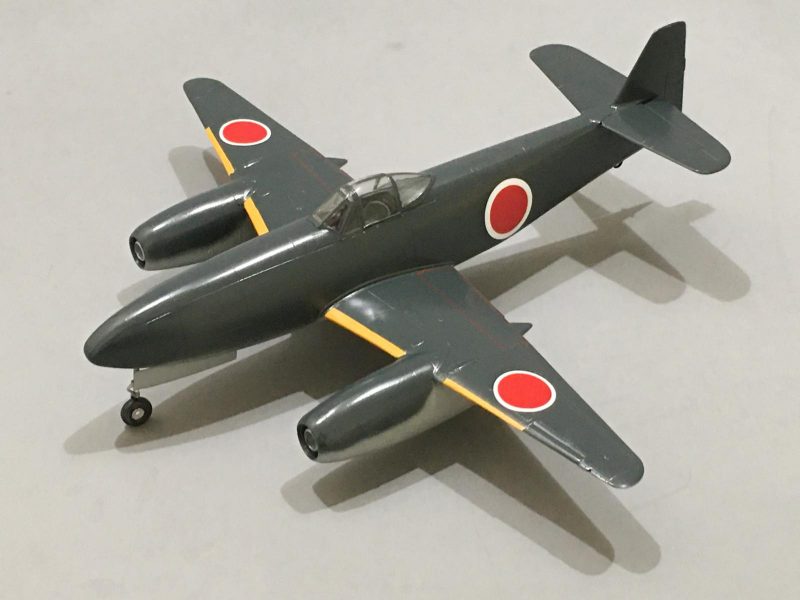

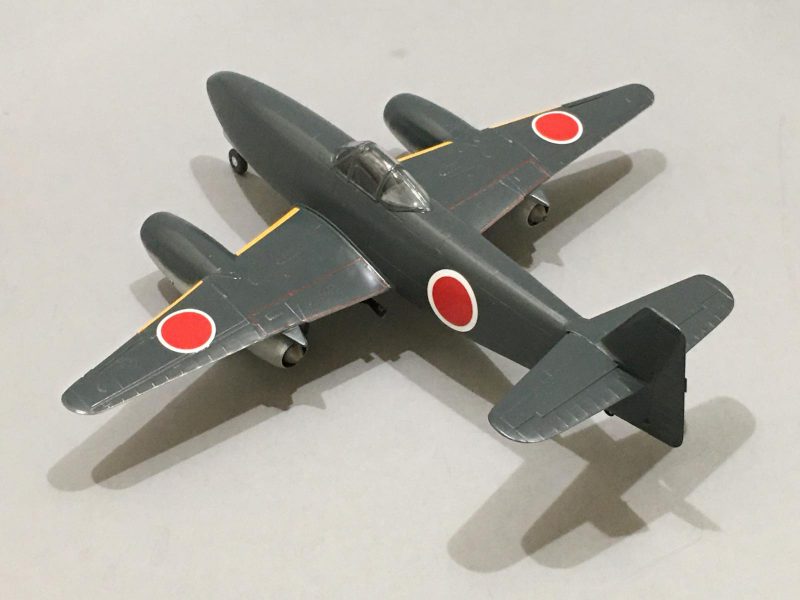
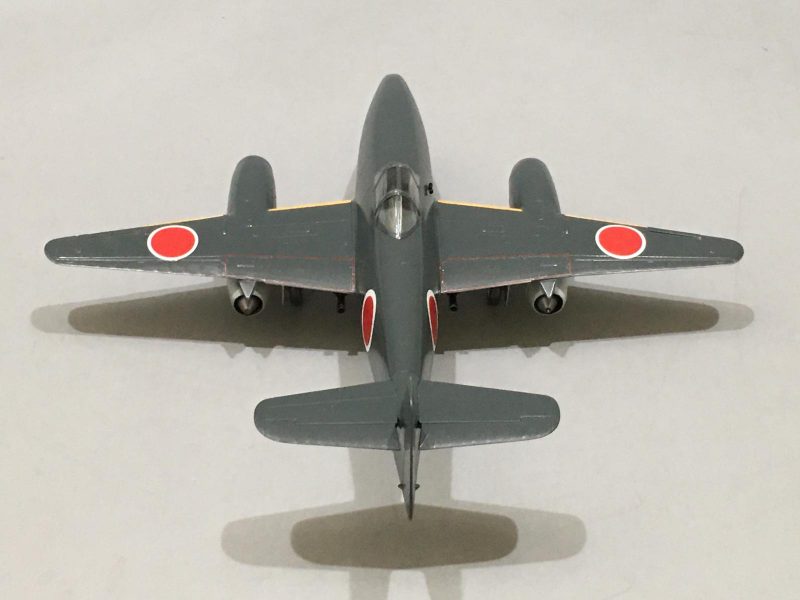
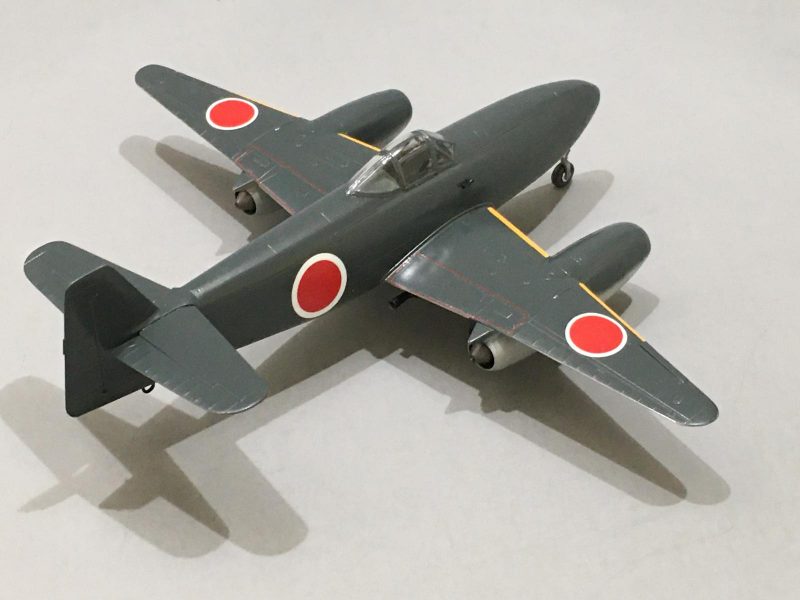
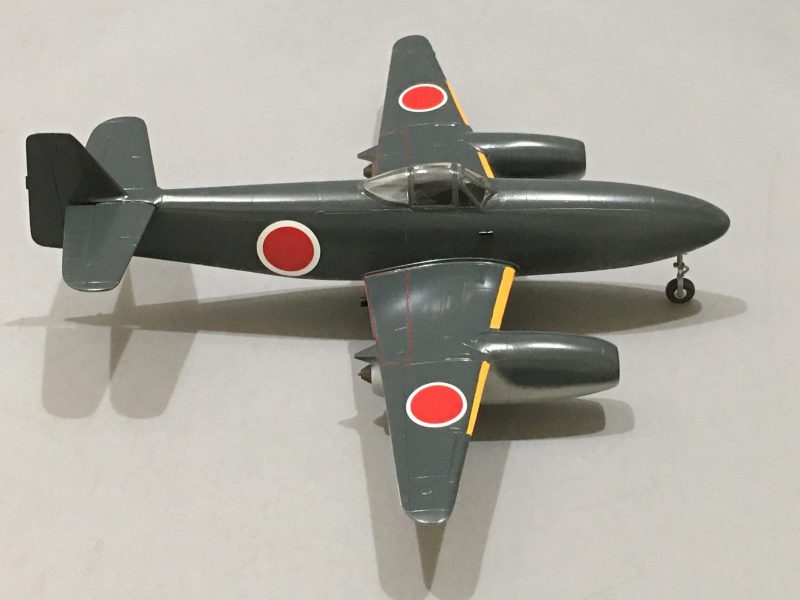

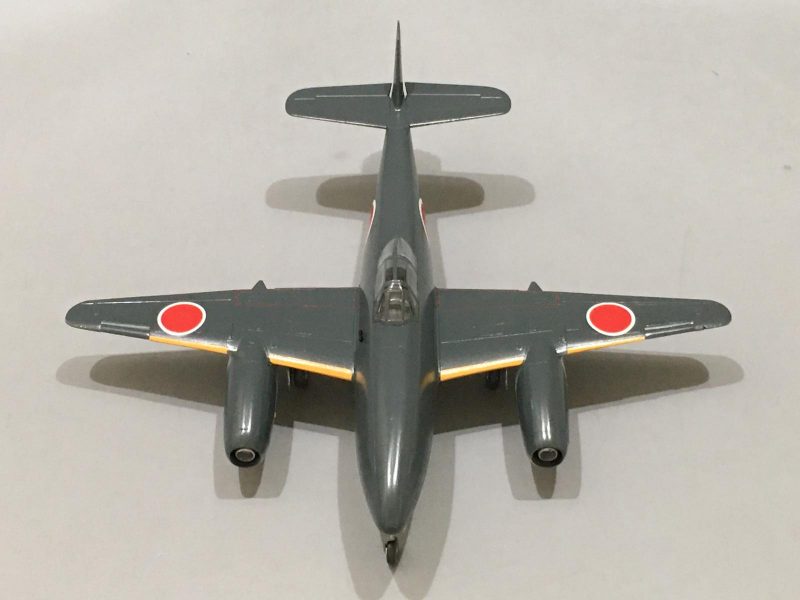



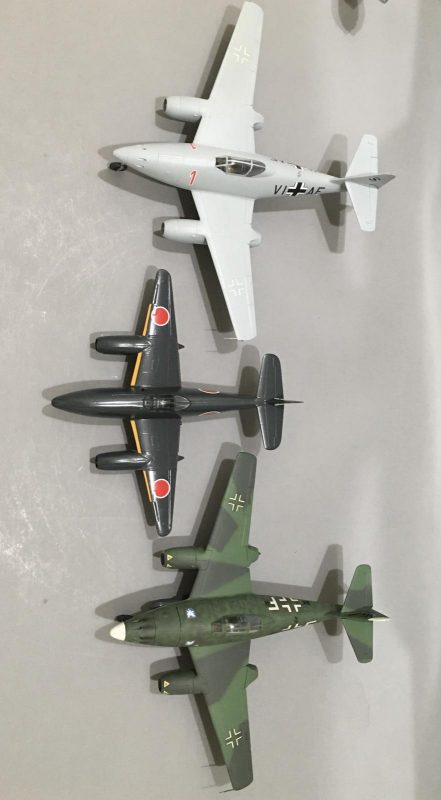
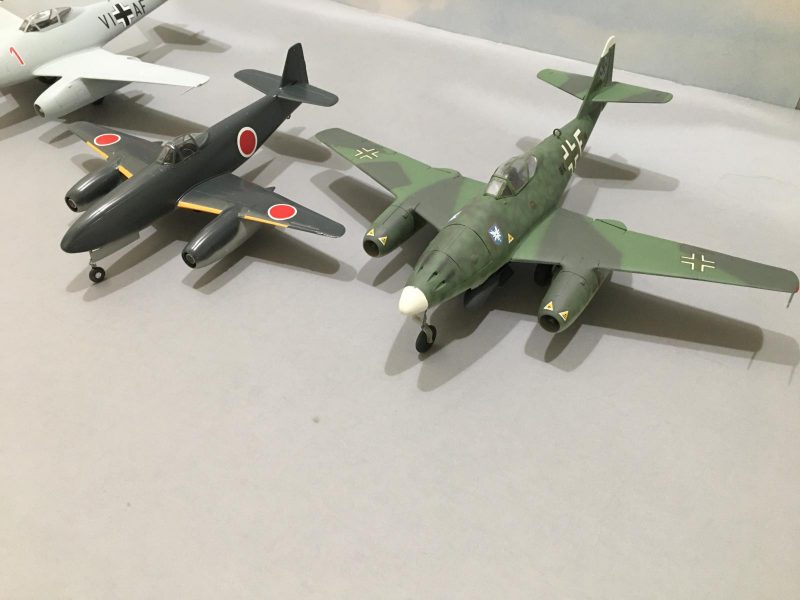
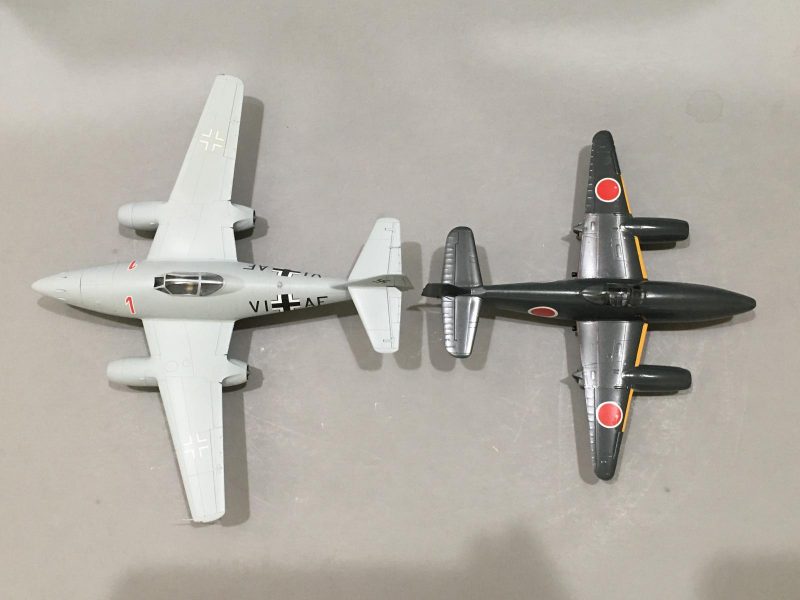
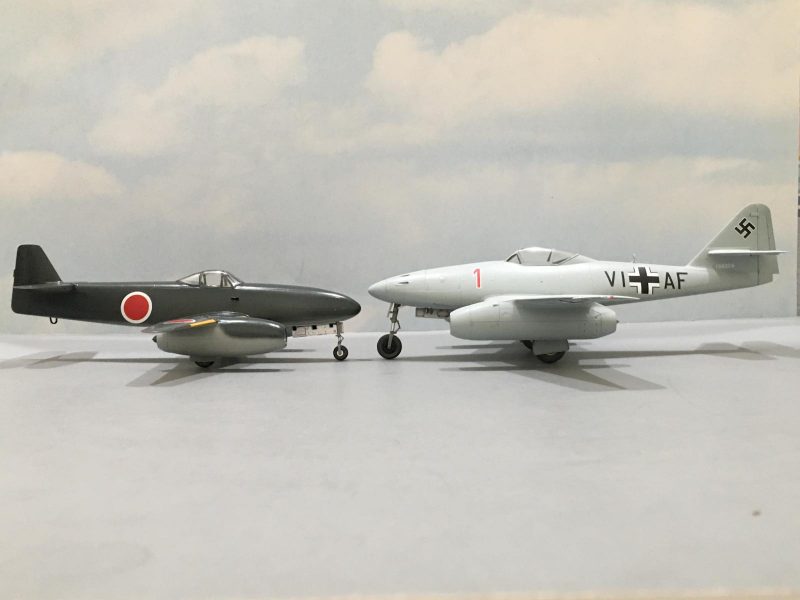
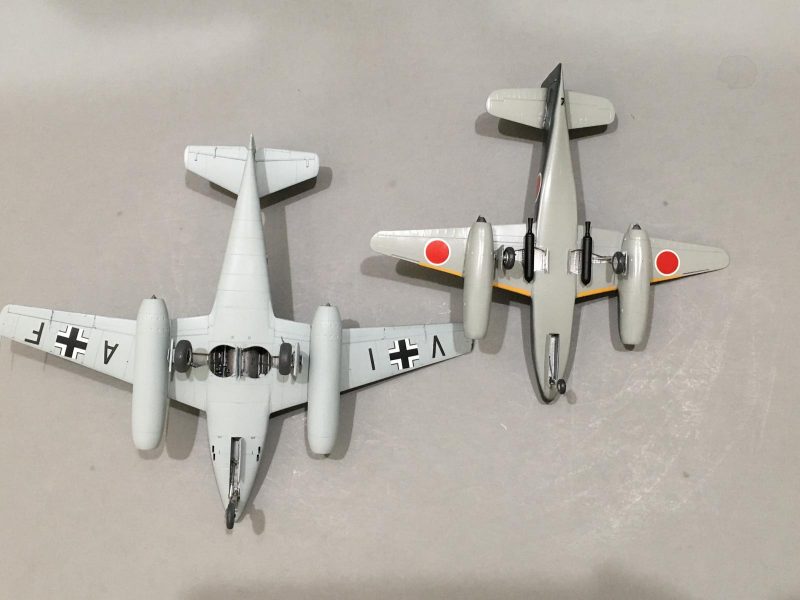
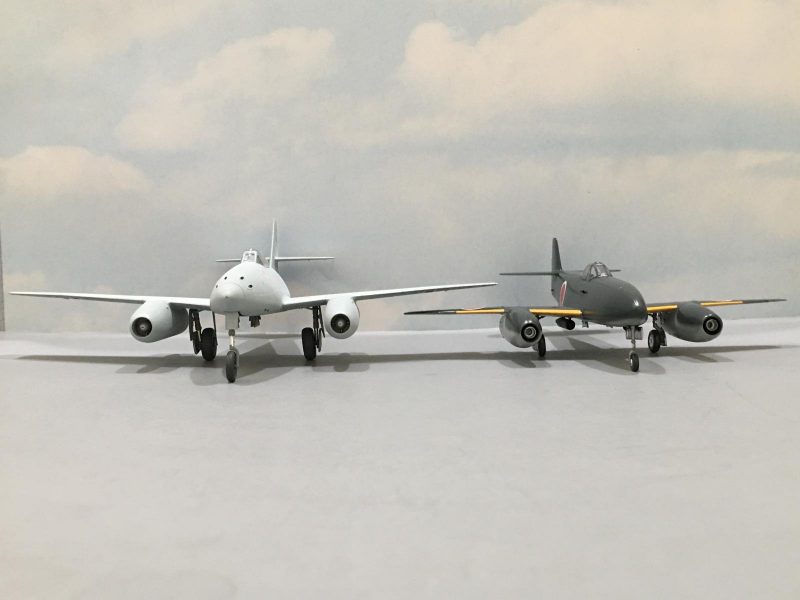
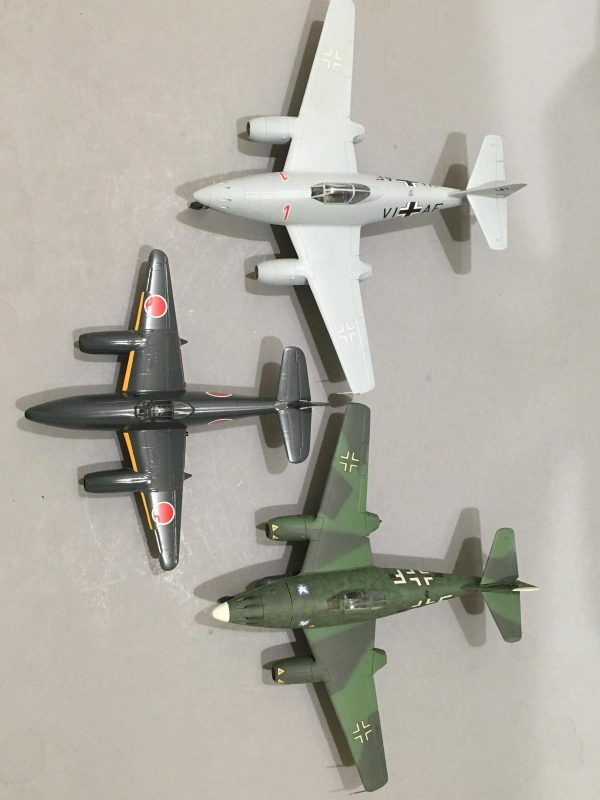
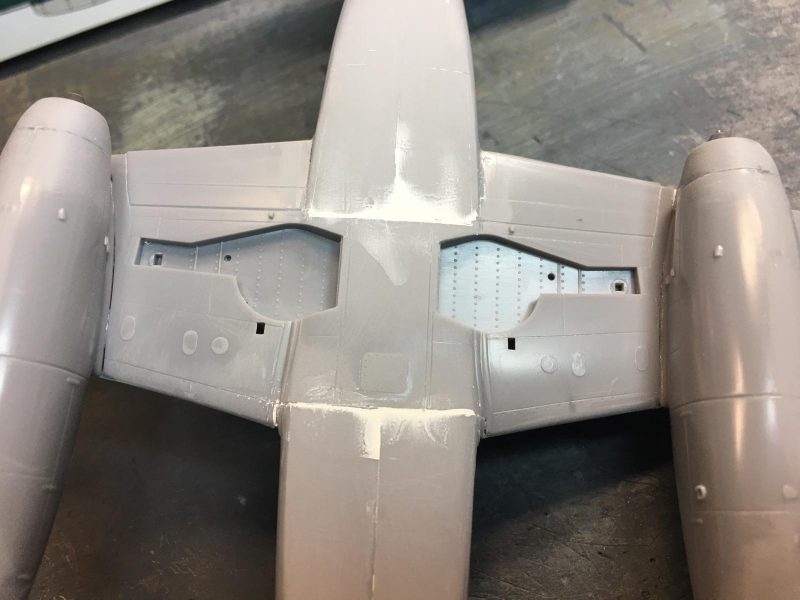
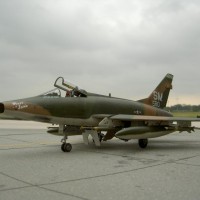
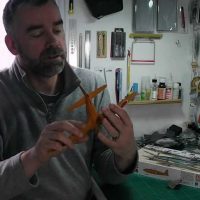

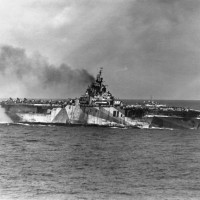
As always looks great Louis! Love the paint and the Bare metal foil in the wheel wells.
Very nice model of a lesser known craft. I'm quite surprised how much smaller it is than a 262. Thanks for sharing!
Nicely done, and informative article, Louis. The 262's look really good, as well!
That's a fantastic result, Louis @lgardner!
Having followed your build, I say that it was a total joy to follow.
I love the looks of the Kikka and you brought them on with excellency.
Thanks for the historical info, too!
An excellent build.
So much smaller than a 262, I was not aware of that.
Nice build and I enjoyed the history as well. I always thought it was pretty much a copy of the 262 and am surprised at how much smaller it actually is.
Turned out nice!
I did the same comparison pics with the 262 when my dad built his Kikka
@lgardner Louis, the inclusion of the Kika in the EoJ GB is a most welcome one since it was the peak of WW2 Japanese technology, and as it is so well described by your article, this technology was far behind their opponents and even their axis ally by a long shot. Great model indeed mate !
Great job Buddy! Like the group comparison shots.
(not the main subject here but I've always liked that light blue 262. It's on my to-be-built list)
Well done Louis , I see you've really done your homework on this A/C. That's some excellent research which covers the development of this particular little jet. So I'll give you an A+ for a grade. Loved the comparison shots with the 262 as well.
Very informative story and your Japanese 262 looks excellent Louis. I like it!
Great looking model of a little known aircraft. Was there any Japanese jet development before the war, like in other Euoropean countries? This model is fab for further development a la Luft 46, whatever that now would be in Japanese...
Thats spectacular! I did not know this had existed. Now I sorta want to build one too, haha. Speaking of which I have to finally get back to that 1/48 corsair I started for this build...
Just beautiful! Your 262's look great also.
Nice job, Louis. That’s one we never see built. Nice smooth paintwork.
This GB is really producing some really neat and rare Japanese aircraft. Along with the more well know Japanese aircraft that operated in theatre. This Kikka is a first that I have seen built and is simply marvelous. The history of this and the growing pains that Japan was quickly learning in producing jet powered aircraft is quite apparent and turned to the Luftwaffe for some guidance and advice which eventually helped in development of the Kikka. The size comparison to the Me-262 is quite apparent and also the similar design as well. Another good kit from Fine Molds which I myself was not aware of. They have some really nice subjects in their line that Hasegawa and the other's have not produced. Great presentation, Louis, now waiting to see what else you have in store for us. Thanks for sharing...
Great build, Louis (@lgardner). You can't go wrong with a Fine Molds kit. Thanks for the comparison with the Me 262, as I always think they are basically the same, but obviously not when compared side-by-side. I have one lurking in the garage somewhere, but there are a bunch in line before the Kikka.
Looks great. I had no idea the Kikka was so small. Glad you added the 262’s for comparison.
Very nice build.
I need to add one to my collection, too.
This one is a very rare subject too see and so lucky too see it.
Very nice model Louis, good clean work and lines.
Not near as elegant as the 262, but WOW - I didn't realize how small it was until I saw it next to your 262's! A very nice addition to the EOJ build - an unusual subject, that I realized I don't have in my stash. I may have to see if I can find one in 1/72. Nice build Louis!
Thank you everyone for leaving such wonderful comments about this build. I will come back later and give an individual reply to each of you soon. It's getting late here now and I'll be signing off.
Take care and stay healthy. Thanks again !
Hey Louis,
What a stunner! While this fell short of the performance of the Me-262 it is scary to consider what might have been if the axis countries had got into the swing of production and perfected designs. Fine Molds reputation has certainly been boosted by this GB! Beautiful build!
Louis @lgardner, Great job! Sorry for the late response, trying to catch up and get back in the game.